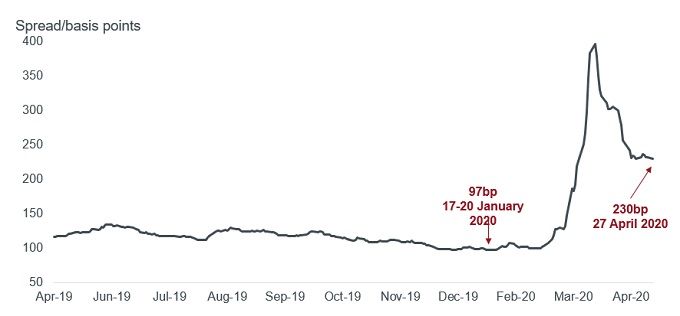
Janus Henderson Investors: Bridging the gap - credit markets in the COVID crisis
Jenna Barnard and Nicholas Ware, Portfolio Managers in the Strategic Fixed Income Team, provide an update on the shape of the recovery in corporate bond markets following the virtual heart attack experienced in March.
04.05.2020 | 12:38 Uhr
Key takeaways:
- Catalysed by the actions of the US Federal Reserve, the primary market for US corporate bonds reopened quickly in this crisis — while the floodgates opened for investment grade issuance in March, the high yield market reopened with a bang in April.
- What has stood out to us in the credit market trenches is the exceptional willingness of corporate bond markets to provide access to liquidity to a variety of companies, which will likely dampen default rates, relative to the decline in the economies, going forward.
- The crisis has accentuated the bifurcation between quality names that have access to cheap capital and value/zombie sectors, which do not.
Following on from our article in early April (Credit over equities — coupons over dividends?), in which we expounded a positive view on corporate bonds we wanted to update investors on the shape of the recovery in the corporate bond markets following the virtual heart attack experienced in March. Specifically, we attempt to highlight the exceptional willingness of corporate bond markets in this crisis to provide access to liquidity to a variety of companies, which we believe may dampen default rates relative to the decline in gross domestic product (GDP).
In many respects this has been a crash experienced at dizzying speed and ferocity, both in the collapse in financial market plumbing and the subsequent recovery; catalysed by the US Federal Reserve announcing plans to purchase investment grade and fallen angel high yield corporate bonds. What has stood out to us in the credit market trenches is the willingness of the corporate bond market to lend. This is shown by how quickly the market has reopened for primary issuance (ie, new issues), the scale of the issuance being undertaken and the range of companies able to access this liquidity.
This article provides a few such examples and statistics to highlight current developments. The shape of the recovery in cash flow and earnings will ultimately determine whether these companies can service and repay the additional debt that they are taking on. However, the willingness of credit markets (and governments) to bridge the coming quarters is a salient feature, which makes this experience different to the past. It is worth noting that during the Global Financial Crisis (GFC) high yield issuance outside of the US ground to a complete halt for close to 18 months, while US high yield issuance itself reduced dramatically between July 2008 and March 2009.
What follows is a brief snapshot of what is happening today.
Investment grade market: floodgates are open
The whole of the US$6.7 trillion US investment grade market is currently open to its constituents, with the only question being one of price. Beginning in mid‑March, high quality issuers like Proctor & Gamble, Kimberly Clark and Disney reopened to the primary market with new issues priced at exceptionally cheap levels relative to existing bond curves (which themselves had already been repriced aggressively in the sell-off).
The whole of the US$6.7 trillion US investment grade market is currently open to its constituents, with the only question being one of price. Beginning in mid‑March, high quality issuers like Proctor & Gamble, Kimberly Clark and Disney reopened to the primary market with new issues priced at exceptionally cheap levels relative to existing bond curves (which themselves had already been repriced aggressively in the sell-off).
By late April, we find much smaller new issue premiums on offer and in select cases (eg, Constellation Brands and Eli Lilly) new bonds are actually pricing at more expensive levels than their existing bonds, as investors are more concerned about the ability to buy bonds than the price. This must, however, be considered in the context of the overall valuation of the market (see chart) in which investment grade credit spreads traded at 230 basis points (bp) on 27 April 2020, versus a market that traded as tight as 97bp in January.
Chart: dramatic movements in US investment grade bond spreads since March

Source: Bloomberg, ICE Bank of America, US Corporate Index, as at 27 April 2020.
This excess demand (with new issue oversubscription running at 4.3x year‑to‑date, versus 3.2x for the whole of 2019) has occurred despite a record‑breaking pace of supply, with investment grade issuance elevated to US$258bn in March and US$225bn expected in April. Of note, a strong year in investment grade issuance in the US is approximately US$1trillion; so, these monthly issuance numbers are quite extraordinary. As of 23 April 2020, issuance year‑to‑date is running at US$673.5bn, which is up 71% versus 2019 and is on pace to be a record year of issuance, which we project could be as high as US$1.5trn.
In March, there was a greater share of high quality companies issuing, rated A or better, but encouragingly this has since migrated to BBB rated paper in April as risk appetite has returned. Reasons for issuing include a general bolstering of liquidity in the face of the coronavirus and oil‑related uncertainty, and a replacement of existing liquidity facilities following the breakdown of the US commercial paper market and the subsequent drawing down on bank facilities in March, which are now being replaced with financing from the bond market.
High yield: secular winners and losers from the coronavirus pandemic
Moving down the rating spectrum to high yield (US market size, US$1.2trn) the primary market has again reopened with a bang (the week of 20 April saw the second highest week of issuance on record) but the picture is inevitably more selective in terms of who has access to this capital.
Indeed, the crisis has accentuated the bifurcation between quality names that have access to cheap capital and the value/zombie sectors that do not. There is a cohort of ‘value plays’, which tend to be in cyclical, legacy industries where this crisis could well be their last. Here it is not just a liquidity issue but also a solvency issue. We struggle, unlike a lot of market participants, to price that risk and to see a path for these businesses to get out of their predicament given they are burdened with debt, which means cash flows are diverted to servicing debt rather than improving the underlying business.
A good example of a secular winner is Netflix, which was able to issue at an historically low US high yield new issue coupon of 3.625%, while cinema chain AMC had to issue at a whopping 10.5% coupon in the past fortnight. The high yield market was shut for just three weeks during this crisis before reopening in the last week of March with issuance from Yum Brand International that priced a bond at a 7.75% coupon.
Beyond the safe and stable companies, the ability to raise capital is inevitably a case‑by‑case basis with even some of the businesses in the eye of the coronavirus pandemic now able to approach the market, including theme park operator Merlin and also hotel chains Marriot International and Hilton Hotels. We are being asked to provide financing to quality businesses that were doing well pre-coronavirus, that do not have a solvency issue but are asking to bridge a liquidity gap for their company. We are willing to take that risk provided they come with an attractive coupon and that the deals are structured well. These are businesses where we are prepared to look through the near‑term coronavirus related weakness and forecast that post the events, they will come out stronger, as some of the competition falls by the wayside.
Risk is back on the menu
Risk is back on the table for investors with cash to put to work. However, we have to remember a core tenet of our sensible income philosophy: does this business have a reason to exist? There have been a number of new bond issues by well‑known entities recently, which we did not find suitable investments for our portfolios, as we envisage the companies having a challenging path forward, even without the coronavirus outbreak to contend with.
Then there is the last type of company, the walking dead. These were issuers that already faced challenges before the pandemic, which are now being brought to the fore. We have seen a surge of defaults and missed payments coming from the telecom, energy and retail sectors in April. These companies are taking the opportunity to ‘right size’ their capital structure through wiping out debt and equity of current holders. In April, we saw Frontier the US telecommunications company with $15bn of debt voluntarily file for Chapter 11 as well as Intelsat, the satellite operator, with $11.7bn of debt miss a coupon payment. The way we see it, before investors are willing to commit any further capital to these companies they will want to see a capital structure where, if they do commit capital, they are not throwing good money after bad.




Diesen Beitrag teilen: